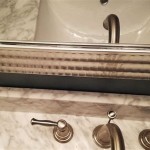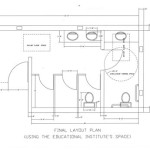59 Inch Bathroom Vanity Double Sink Dimensions: A Comprehensive Guide
The 59-inch bathroom vanity with a double sink configuration represents a popular choice for medium to large-sized bathrooms. This size offers a considerable balance between countertop space, storage capacity, and the convenience of accommodating two users simultaneously. Selecting the right vanity involves careful consideration of its dimensions, material, style, and the overall impact it will have on the functionality and aesthetics of the bathroom.
Understanding the dimensions of a 59-inch double sink vanity is crucial for ensuring compatibility with the existing bathroom layout and plumbing. Typically, the stated dimension of 59 inches refers to the width of the vanity. However, other dimensions, such as depth and height, also play a significant role in determining the suitability and ergonomic comfort of the unit.
This article provides a comprehensive overview of the dimensions associated with a 59-inch bathroom vanity featuring a double sink. It will delve into the standard measurements, key considerations for installation, and the various factors that influence the perceived and actual space occupied by the vanity. Furthermore, it will discuss the implications of these dimensions on storage, plumbing requirements, and the overall bathroom design.
Standard Dimensions of a 59-Inch Double Sink Vanity
While the width of a 59-inch double sink vanity is fixed, the other dimensions can vary depending on the manufacturer, style, and design of the unit. It is important to verify the specific dimensions provided by the manufacturer before making a purchase to ensure a proper fit.
Width: As the name suggests, the width of the vanity is typically around 59 inches (approximately 150 cm). However, there can be slight variations of a few inches, so it is important to consult the product specifications. This width allows for two sinks to be comfortably accommodated side-by-side, along with some surrounding countertop space.
Depth: The depth of a 59-inch double sink vanity usually ranges from 18 to 22 inches (approximately 45 to 56 cm). This dimension dictates how far the vanity will protrude into the bathroom. A deeper vanity typically offers more countertop space and storage capacity, but it can also make the bathroom feel smaller if the space is limited. A shallower vanity, on the other hand, maximizes floor space but may compromise on storage and countertop area.
Height: The height of a standard bathroom vanity typically falls between 30 and 36 inches (approximately 76 to 91 cm). The ADA (Americans with Disabilities Act) compliant height is often around 34 inches. The optimal height depends on the user's height and preferences. A taller vanity can be more comfortable for taller individuals, while a shorter vanity may be more suitable for children or individuals with mobility issues. The choice of sink type (undermount, vessel, integrated) will also affect the overall height of the countertop.
Sink Dimensions: The dimensions of the individual sinks also impact the overall functionality of the vanity. Typical sink dimensions range from 15 to 20 inches in width and 10 to 15 inches in depth. The shape of the sink (rectangular, oval, round) also influences its usable space and aesthetic appeal. Consider the sink depth, as shallower sinks might result in splashing, while deeper sinks can be uncomfortable for some users.
Cabinet and Drawer Dimensions: The internal dimensions of the cabinets and drawers within the vanity will determine the storage capacity. Consider the types of items you plan to store in the vanity (towels, toiletries, cleaning supplies) and choose a vanity with compartments that suit your needs. Full extension drawers provide easy access to items stored at the back, while adjustable shelves allow for customized storage configurations.
Key Considerations for Installation and Space Planning
Proper planning is crucial for a successful vanity installation. This involves carefully measuring the available space, considering the placement of plumbing lines, and accounting for clearances around the vanity.
Clearance Space: Ensure adequate clearance space around the vanity for comfortable movement. A minimum of 30 inches of clear space in front of the vanity is recommended, while 36 inches is ideal. This allows users to comfortably stand and use the vanity without feeling cramped. Also, consider the swing of the bathroom door and ensure it does not obstruct access to the vanity.
Plumbing Placement: Verify the location of existing plumbing lines (water supply and drain) and ensure they align with the vanity's plumbing connections. If necessary, consult a plumber to relocate or modify the plumbing lines prior to installation. Failure to do so can result in costly and time-consuming modifications later on.
Wall Support: Determine the weight of the vanity and ensure the wall is adequately reinforced to support it. If the vanity is particularly heavy, consider adding additional support behind the wall. This is especially important for floating vanities that are not supported by legs.
Flooring: Before installing the vanity, ensure the flooring is level and in good condition. An uneven floor can cause the vanity to wobble and put stress on the plumbing connections. If necessary, level the floor prior to installation.
Lighting: Plan the lighting around the vanity to ensure adequate illumination for tasks such as grooming and applying makeup. Consider installing sconces on either side of the mirror or a light fixture above the mirror. Proper lighting enhances both the functionality and aesthetics of the vanity area.
Mirror Selection: The size and style of the mirror should complement the dimensions and style of the vanity. A mirror that is too small can look out of proportion, while a mirror that is too large can overwhelm the space. Choose a mirror that is visually appealing and reflects the overall design of the bathroom.
Impact of Dimensions on Storage, Plumbing, and Design
The dimensions of a 59-inch double sink vanity directly impact the available storage space, the plumbing requirements, and the overall design aesthetic of the bathroom.
Storage Capacity: The depth and height of the vanity directly influence the storage capacity. A deeper vanity offers more room for drawers and cabinets, allowing for more effective organization of toiletries and other bathroom essentials. A taller vanity can accommodate larger items, such as towels and cleaning supplies. Consider the types of items you need to store and choose a vanity with compartments that suit your needs.
Plumbing Considerations: The placement of the sinks and the drain lines will impact the plumbing installation. Double sink vanities typically require two sets of water supply lines and a double drain assembly. Ensure the plumbing is properly installed and that there are no leaks. Consider the accessibility of the plumbing connections for future maintenance.
Design Aesthetic: The dimensions of the vanity play a significant role in the overall design aesthetic of the bathroom. A 59-inch double sink vanity can make a statement in a medium to large-sized bathroom, adding a touch of luxury and sophistication. Choose a vanity style and finish that complements the existing décor of the bathroom. Consider the color scheme, materials, and overall style of the vanity to create a cohesive and visually appealing space.
Countertop Space: A 59-inch vanity, even with two sinks, provides reasonable countertop space. This space is valuable for placing everyday items like soap, lotions, and decorative elements. The material of the countertop, such as granite, quartz, or marble, can impact the overall aesthetics and maintenance requirements.
Sink Style and Placement: The type of sink (undermount, vessel, drop-in) affects the overall height and appearance of the vanity. Undermount sinks offer a seamless look and are easy to clean, while vessel sinks add a unique design element. The placement of the sinks should be symmetrical and aesthetically pleasing.
Material Selection: The materials used in the construction of the vanity (wood, MDF, particleboard) impact its durability and appearance. Solid wood vanities are generally more durable but also more expensive. MDF and particleboard vanities are more affordable but may not be as resistant to moisture. Choose materials that are suitable for the bathroom environment and that complement the overall design.
In summary, understanding the dimensions of a 59-inch double sink vanity is crucial for ensuring a proper fit, maximizing storage and functionality, and creating a visually appealing bathroom space. Careful planning and consideration of these dimensions will result in a successful installation and a bathroom that meets the user's needs and preferences.
Before finalizing the purchase of a 59-inch double sink vanity, always double-check the manufacturer's specifications and compare them to the available space in the bathroom. This will help to avoid any surprises during installation and ensure a satisfying outcome.

Wyndham Collection Sheffield 60 Single Bathroom Vanity In White No Countertop Sink And Mirror

Wyndham Collection Sheffield 59 In W X 21 5 D 34 25 H Double Bath Vanity Cabinet Without Top White Wcs141460dwhcxsxxmxx The Home Depot

Wyndham Collection Sheffield 59 In W X 21 5 D 34 25 H Double Bath Vanity Cabinet Without Top White Wcs141460dwhcxsxxmxx The Home Depot

59 Inch White Double Sink Bathroom Vanity Black Metal Stand Unique Vanities

59 Double Sink Bathroom Vanity Cabinet With 6 Drawers

59 Ophelia Double Sink Vanity Bathgems Com

Stufurhome Valeria 59 Gloss White Wall Mounted Double Sink Bathroom Vanity With Rectangular Resin Sinks 2 Drawers Doors And Pre Drilled

59 88 In W X 22 D Double Sink Freestanding Bath Vanity White With Rubberwood Cabinet And Stone Top

Jwh Living Furniture By Size 59 Inch Bathroom Vanities Quot Lune Double Vessel Sink Vanity Glass

59 Inch White Floating Double Sink Bath Vanity Gold Accents Unique Vanities
Related Posts







